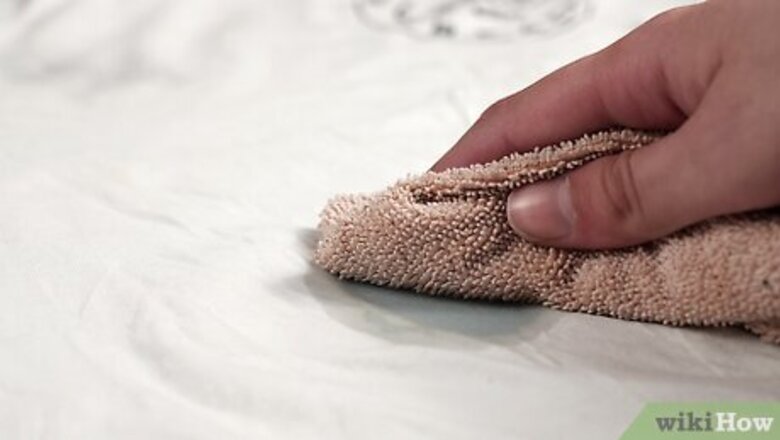
views
Removing Oil Stains from Clothing and Fabric
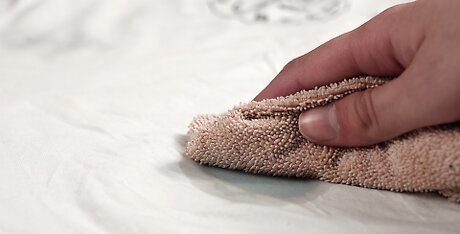
Remove excess oil immediately with a rag or paper towel. When it comes to oil stains, the more oil you can get out of the fabric before it sets, the better. As soon as you notice a stain on your clothing, try to blot out as much of the oil as you can with a rag or paper towel. This won't prevent a stain by itself, but it will make the stain as minor as possible as well as helping to make the stain easier to remove. If the stain is caused by a thicker oil, such as butter, mayonnaise or car grease, try scraping up the excess oil with a butter knife, rubbing it on a paper towel, and discarding it. Be sure to use a blotting motion to remove the oil. Don't try to rub the stain out — this can spread the oil, rather than removing it.

If working with clothes, use a cardboard insert. The method in this section should work for oil stains in most fabrics, including those used in clothing. If your oil stain is in a piece of clothing, be sure to insert a thin piece of cardboard, plastic, or another non-permeable material into the clothing under the stain before you start to treat it. This keeps the oil from soaking through to the layer underneath and also prevents any cleaning materials you use from doing the same. For other types of fabric, like sheets and upholstery, you may not need to (or simply may not be able to) use an insert to protect any layers of fabric under the first.
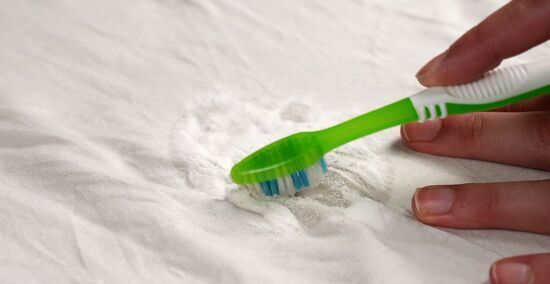
Apply talc or baking soda to the stain. To soak up extra oil that's already worked its way into the fabric, try using a neutral absorbent powder like baking soda, talc, baby powder, etc. Gently work the powder into the fabric with an old toothbrush to soak up excess oil. You should notice solid clumps of powder begin to form — this means that your powder is beginning to absorb the oil. Dust the clumps off as they form and continue scrubbing. Add more powder as needed. You'll want to gently brush until you notice the solid clumps of powder becoming infrequent (this usually takes about five minutes or less). When you're finished, wash the powder out by rinsing lightly with water and scrubbing gently with the same toothbrush you used to work it in.
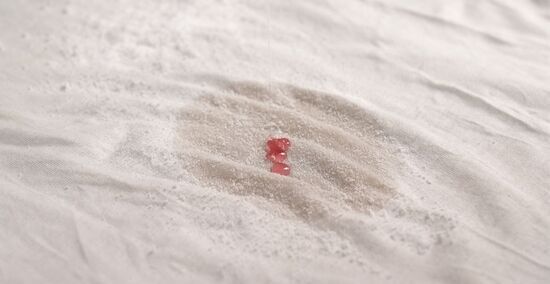
Work grease-cutting dish soap into the stain. Next, grab a bottle of liquid dish soap (note: not dishwasher soap) and squeeze a small drop onto your stain. Wet your toothbrush with water, then gently scrub the soap into the fabric. Scrub for about two to five minutes to allow the soap to dissolve the oil in the fabric. If you're working with a piece of fabric that can't go in the washing machine, like, for instance, a delicate wool scarf or a section of upholstery on your couch, you may now want to wet your toothbrush and work the water into the fabric as a makeshift "rinse". Allow to dry, then repeat the steps above as needed (or see below for alternatives).
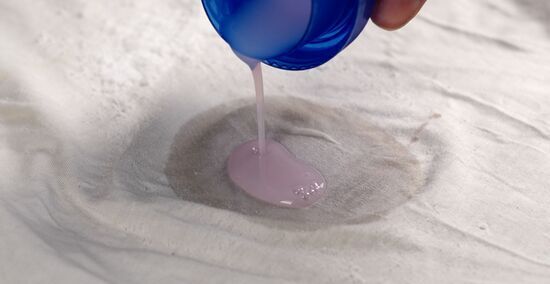
Pre-treat the stain with detergent. If you're dealing with an oil stain in clothing or another piece of fabric that can go in your washing machine, you'll want to finish your stain-removal cycle by tossing your item in the wash. Before doing this, apply a small amount of your laundry detergent directly onto the stain and gently scrub it in with your toothbrush. Applying detergent directly to a stain before washing is an old stain-removal trick that useful for nearly all types of stains. The extra detergent ensures that the affected area receives an especially deep cleaning during the wash cycle.
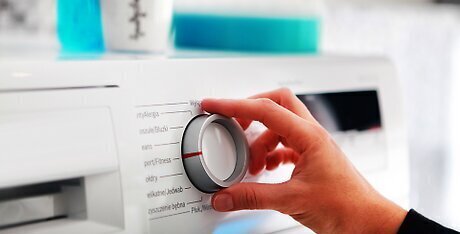
Place your clothing or fabric in the laundry. Add your pre-treated clothing or fabric to the washing machine with a load of similar items. Follow all directions on your clothing or fabric's care label when picking your wash settings. For the greatest cleaning power, use the largest amount of detergent and the hottest temperature of water allowed. When your load is finished, machine or air dry it as your normally would. If you used an insert, don't forget to remove it before adding your item to the wash.

Repeat as needed. When your garment or fabric is completely dry, check the area of the stain for any remaining oil or discoloration. At this point, most minor stains should be completely removed. However, heavy stains, dried-on stains, and stains from especially thick oils may require several cycles to completely remove. If you're dealing with a white piece of fabric, you can try treating your stain with bleach to remove any lingering discoloration on your subsequent cycles as long as you make sure to wash your item in a load of whites.
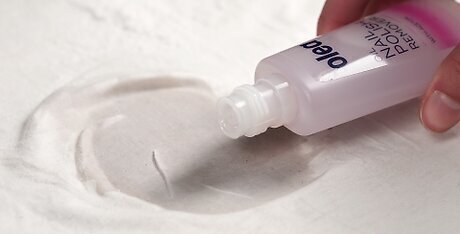
Try alternative stain-removing solutions. For most clothing and fabrics, the method above, which uses only common household materials, should work well for removing the majority of oil stains. However, it's far from the only method used for this task. Many different methods which use less-common materials also exist — if you're having trouble removing a particularly stubborn stain, you may want to try using one of the solutions below in your stain-removal routine. Acetone: This chemical, often used as a nail polish remover, is sold in most health and beauty stores. Be sure to use only pure acetone — not an acetone-based product with fragrances or dyes. Drizzle acetone directly onto your stain and dab with a towel to spread it. Repeat as needed, then soak up the acetone and launder as normal. Note that acetone should not be used with modacrylic, acetate, triacetate, or natural hair fibers like silk and wool, as it can damage these fibers. Rubbing alcohol: Isopropyl alcohol, also known as rubbing alcohol, is a natural de-greasing agent sold in most department stores. Try treating your stain by dabbing it with a cloth soaked in alcohol before laundering. Spray lubricants: Believe it or not, some spray-on lubricants like WD-40 can be used to help remove oil stains. Try spraying the affected area with lubricant, then allowing it to sit for about half an hour while the lubricant soaks in. Finally, pre-treat your fabric with detergent and wash as described above.
Removing Oil Stains from Carpet
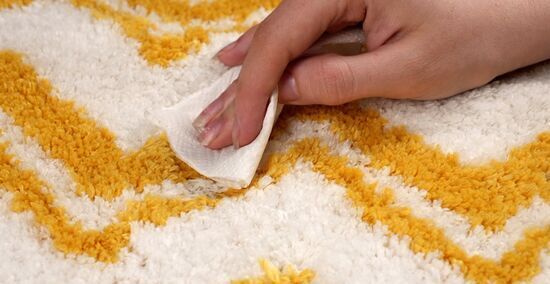
If possible, soak up excess oil immediately. As tough as it can be to remove stains from ordinary fabric, carpet can can be even more difficult. The tight interwoven fibers of most carpets can make it especially tricky for cleaning agents to penetrate to the oil, so you'll want to do as much as you can to remove the stain on your carpet before it sets. If the stain has just occurred, press a folded-up paper towel or rag into the stain into absorb as much of the oil as you can. As noted above, you won't want to scrub with your towel or rag, as this can spread the oil over a larger area. Blot continuously until you're not picking up any more oil. Because it's extra-tricky to remove oil from carpet once it's set, you'll want to concentrate especially hard on removing oil from the carpet before a stain even has a chance to form.

Treat with baking soda and vacuum. Next, as with fabric, you'll want to gently rub a neutral, absorbent powder like baking soda, corn starch, or talc into the stain to absorb extra oil from the carpet. You should notice solid clumps begin to form as the powder absorbs the oil. Unlike with fabric, however, it's difficult to simply brush these clumps out of the carpet, so you'll want to use a vacuum cleaner to remove them.
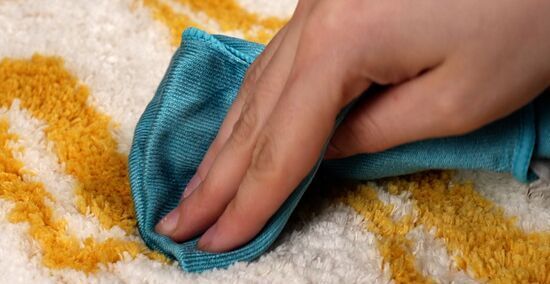
Pour rubbing alcohol on the stain. Next, pour a small amount (no more than a few cupfuls) of rubbing alcohol (also called isopropyl alcohol) onto the stain. Allow the alcohol to soak into the stain and begin to dissolve the oil for about ten minutes. Blot the alcohol out of the carpet with a clean cloth.
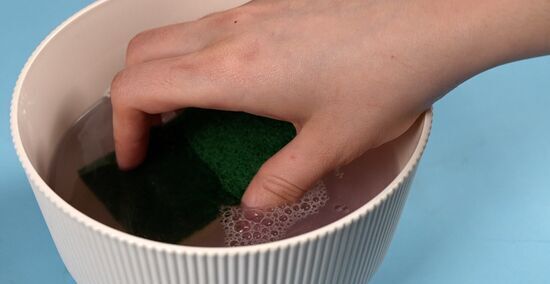
Treat the carpet with a soap/vinegar solution. With a few common household materials, it's easy to make an effective carpet cleaner. Mix 2 cups (473ml) of warm water with 1 tbsp. (14.7ml) of white vinegar and 1 tbsp. (14.7ml) of liquid dish soap. Soak a sponge in the solution. Blot your stain repeatedly, scrubbing gently. Do this for about 5 to 10 minutes or until you notice your stain begin to dissolve. When done, blot your stain with a rag or towel to remove excess moisture.
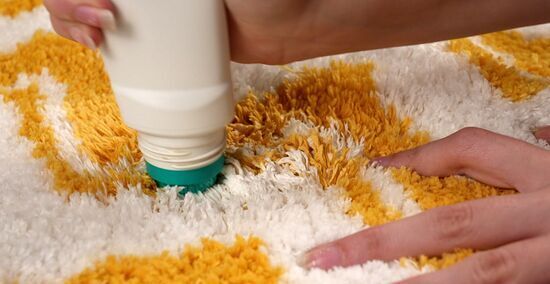
Treat with carpet cleaner. At this point, if you have any commercial carpet cleaner handy, feel free to use it. Because you've already pre-treated your stain with the methods above, the cleaner should be extra-effective. Follow the instructions included with your cleaner to apply it to the stain. Most carpet cleaners will direct you to spray or pour the solution on the stain, let it set, then blot or vacuum the solution out of the carpet.
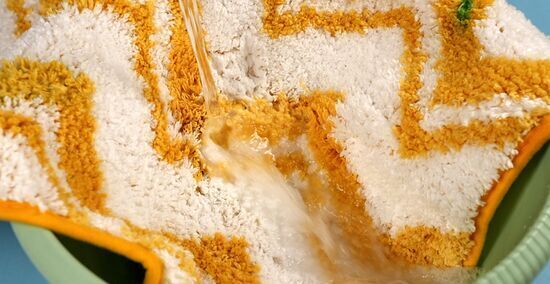
Rinse with cool water. When you're done treating your carpet, wash it with a small amount of cool, clear water. This water works as a "rinse" cycle, helping to dissolve any leftover cleaning materials soaked into the carpet. Some cleaning materials, if left to sit in carpet, can discolor or damage the fibers of the carpet. Others, like the vinegar and soap solution above, aren't necessarily harmful to the carpet, but leave a noticeable odor that shouldn't be allowed to take hold in the carpet. In any case, a little water can help remove leftover substances from the area of the stain. After rinsing with water, immediately blot with a rag or towel. Don't let water soak through the carpet onto the floor, where it can cause damage if allowed to sit.
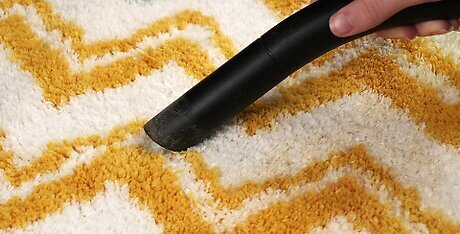
Finish by vacuuming again. Repeat the steps above as needed to work the stain out of the carpeting. When you're finished and the stain has been reduced or removed entirely, give the affected area one final vacuuming. This removes any leftover cleaning materials in the carpet and helps to dry to carpet out, preventing damage than can result from moisture left to sit in the carpet.
Removing Oil Stains from Hard Surfaces
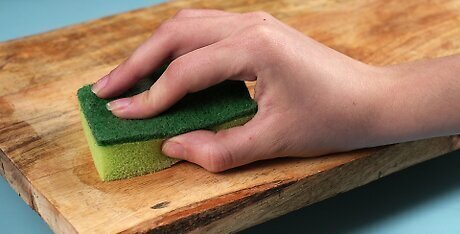
Soak or wash away excess oil immediately. As with the types of oil stains described above, if you have the chance to do so, you'll want to remove as much oil as possible before it has the chance to set. However, since you're working on a hard surface, you don't have to worry about spreading the stain like you would with fabric, so feel free to scrape, wash, or rub the oil away as needed. Cat litter can also help soak up the extra oil. If you're working on your driveway, avoid washing oil into your yard. Some types of oil and certain cleaning solutions can be harmful to plants and grass and can even create unsightly "dead spots" in your landscaping.
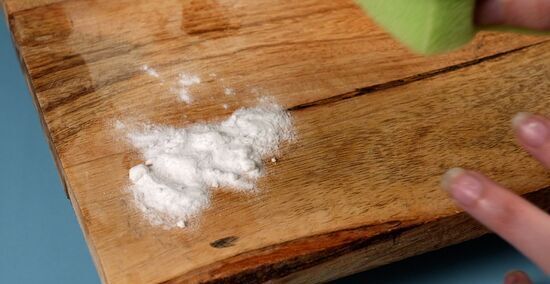
Scrub with baking soda and water and allow to sit overnight. The first action you should take to treat oil stains on hard surfaces is similar, but not identical, to that used for the stains described above. Mix baking soda with water to create a loose (but not liquid) paste, then work the paste into the stain with a sponge or brush. Here, you're using the baking soda as a mild abrasive, rather than for its absorbent properties. When you've given your stain a thorough scrubbing, allow it to sit overnight (or as long as is possible). As it dries, the baking soda paste will absorb the broken-up oil stain, making for easy removal in the morning. For extra cleaning power, you may want to substitute hydrogen peroxide in your paste if you have it.

Soak with warm water and vinegar. Next, make a cleaning solution from water and vinegar as a cleaning solution/rinse. Mix about 2 cups (473ml) of warm water with 1 tbsp. (14.7ml) of white vinegar. Soak a rag in this mixture, then use it to spread the solution over the stain area, removing any dried baking soda in the process. Allow the solution to sit for about half an hour so that it can soak in and help dissolve up the stain.
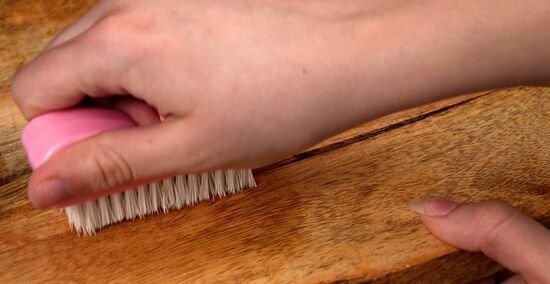
Scrub the stain with an abrasive or stiff brush. When you've allowed your makeshift cleaning solution to soak into your stain, remove it with an abrasive that can break up any remaining oil. There are many abrasives that may work here: steel brushes, fine-grain litter, abrasive pads, toothbrushes, and even sand can perform well. If you're working on a hard surface that is vulnerable to damage or scratching, like a stove top, you will want to shy away from harsher abrasives like steel, sand, and so on. Instead, use a toothbrush or sponge.
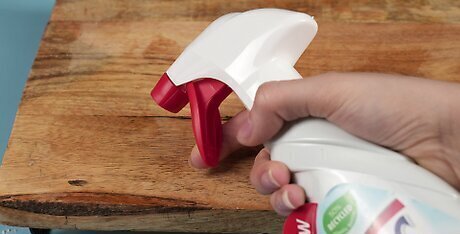
Use a commercial grease-cutting cleaner. If needed, follow up your initial cleaning and scrubbing with a commercial cleaner to finish the job. A variety of grease-cutting solutions are available at grocery and department stores for relatively cheap. Some of these solutions are for general usage, while others are specially-formulated for certain surfaces (e.g. ovens, stove tops, driveways, etc.). Though every cleaner will be different, most function in the same way: apply the cleaner to the stain, allow it to set, then scrub it off.
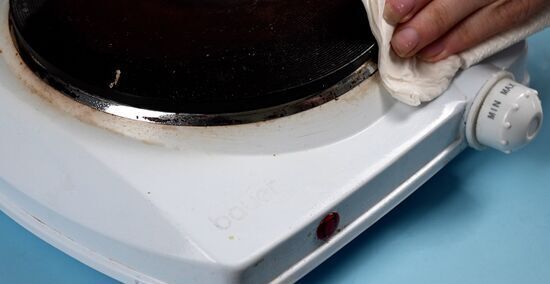
Use mineral oil for kitchen appliance surfaces. For certain hard surfaces in the kitchen where oil stains are common, like the stove top and the fan hood, mineral oil can be an effective cleaner. Soak a paper towel in mineral oil, then scrub the stained areas. For particularly difficult stains, you may want to try adding baking soda to the oil stain. In addition to removing stains, this method gives your appliances a pleasant sheen. You won't want to use mineral oil for your driveway unless the stain is fairly small, as, compared to other cleaners, mineral oil can be somewhat expensive and impractical to work with.
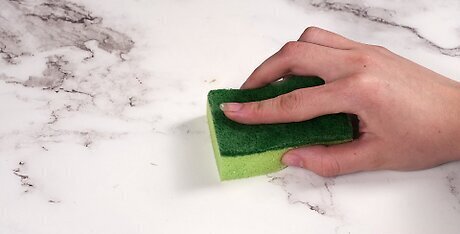
Use trisodium phosphate for concrete. Some driveway stains, like those from dried-on motor oil, can be especially tricky to remove with normal cleaning methods. In these situations, try using trisodium phosphate (TSP), a heavy-duty cleaning powder often sold at specialty cleaning stores. Mix TSP with water to create a smooth paste and spread it over the stain, then allow it to dry. When the paste dries completely, scrub it away with a rag or brush. Repeat as needed until the stain is suitably reduced or removed. Don't rinse dried TSP down the storm drain, as it is known to be harmful to aquatic ecosystems.
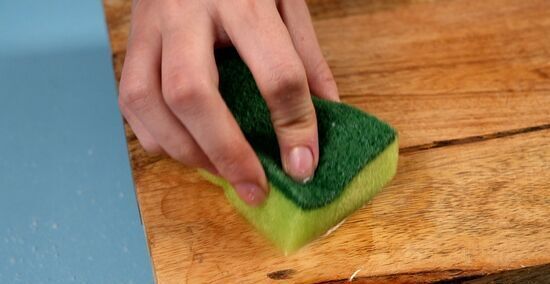
Try using club soda. When all else fails, try this old-fashioned method used by grandmothers everywhere. Pour a small amount of club soda onto your stain, allow it to set for about five to ten minutes, then wipe it away with a rag or sponge. Compared to other cleaning solutions, club soda is mild, but surprisingly effective. Best of all, it's cheap — large bottles of club soda usually only cost a dollar or two at the grocery store.


















Comments
0 comment